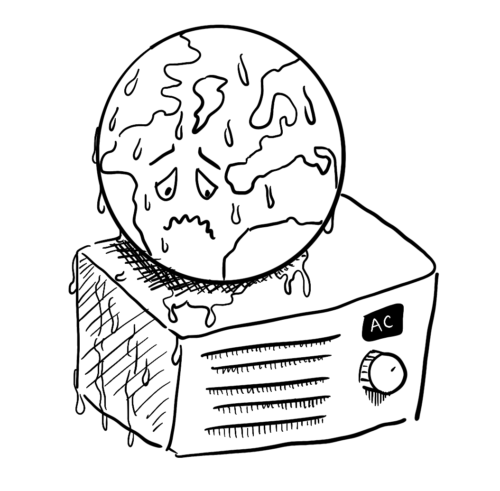Nothing is better than the quintessential feeling of relief from the sweltering summer sun—stumbling into a building’s cold air, sweat evaporating and replaced by an army of goosebumps, life surging back through your veins. Though while much of America may experience such wonders, Harvard students certainly do not
The week of September 4th was seven days of reckoning for Harvard students, as both Cambridge temperatures and campus buildings hovered between 80 to 90 degrees. Sleeping on top of duvet covers, lining walls with portable and box fans, and fully opening windows were all commonplace practices. After finding their usual late-night spots packed with fellow desperate undergraduates, students who usually turn to Cabot “social hour” or the Lamont “grind” were frequenting Widener, simply trying to find a seat in sub-80 degree temperatures.
The Harvard College Dean of Students Office even went as far as to email a heat and safety warning to students, listing the Smith Center, “most” libraries, and athletic center as the embarrassingly few buildings on campus that offer AC. Still, the administration likely scored a win with Harvard’s cheap water heating bill, with cold showers suddenly seeming like the peak of luxury. The 2014 Ice Bucket Challenge may have been on the verge of making a comeback.
While enduring the sweltering heat, it becomes hard for students to find many positives in their living conditions. “The one good thing about having four fans blasting was the white noise,” said Elson Bankoff ’27, commenting on the stifling temperatures of her Matthews Hall dorm room.
Harvard claims they are on a path to sustainability. Air conditioning increases greenhouse gas emissions, and the heating of water burns fossil fuels, so removing both at first glance is eco-friendly. However, those “Make it fast! Let’s save water!” signs in every shower are not fooling anyone, and Harvard’s flagrant lack of investment in student life is becoming egregious. Considering Harvard is sitting on a 53-billion dollar endowment, students are constantly left speculating about where these copious funds go. Is Harvard the newest Greta Thunberg, or are they just really cheap?
Furthermore, student mental health inevitably suffered as a result of the poor living accommodations and sweltering heat. Low energy and restless nights ran rampant. “It was impossible to sleep, and my roommates had ten fans blasting,” said Katia Anastas ’27. With students locked in their dorms, forced to sit directly in front of their fans to complete readings and PSETs, the natural beauty of Harvard Yard and campus life felt out-of-reach. Upperclassmen housing also felt the effects of the heat wave. “Cabot House needs AC,” expressed Nikhil Jain ’26. “The Quad is under-cared for.”
First-year dorm Matthews Hall felt the brunt of Harvard’s divestment in student life throughout the first few weeks on campus. Over the weekend of September 8th, the need to power Crimson Jam apparently surmounted the importance of clean clothes, with the university shutting down the dorm’s laundry rooms. Is it really that difficult to rent an external power source for one night?
Juliette Hulsizer ’27 suggested a solution, citing feelings of mediocrity toward the Crimson Jam event that led many students to feel as though the funding could have gone elsewhere. “Instead of bringing Nicky Youre to Harvard, they should have just installed AC in the dorms,” she commented.
In addition to unbearable heat in the dorms, the dining halls and kitchens underwent unprecedentedly high temperatures. Harvard University Dining Services (HUDS) employees, as well as Harvard students, were in an uproar over overheated halls and bleak working conditions. Though claiming to be air-conditioned, dorms across Harvard’s campus averaged above 80 degrees during the first few weeks of school, overloading (and subsequently breaking) countless ice machines, and causing kitchen staff and HUDS workers to overheat. Harvard response—merely to cancel dining in certain dorms and expect other kitchens’ staff to compensate.
Another possible (yet temporary) solution, and one that would reduce plastic water bottle use, would be to invest in water-bottle fillers in every space on campus, from individual entryways to classroom buildings. Moreover, in Canaday sinks were broken for days, forcing students to brush their teeth with shower water. “It leaves you minty fresh,” said Austen Wyche ’27, chugging Listerine, maximizing the full potential of his 500mL bottle.
Though Harvard supposedly commits to environmental sustainability, their lack of investment in student life, from embarrassing dorm conditions to below average food, is having a clear impact on the student-body. Investing in air conditioning would offer an escape from the sweltering heat of the summer and boost morale on campus. Hopefully next year, Harvard’s newest first-years won’t have to open their Amazon packages in front of a tower fan, praying for the New England fall that Gilmore Girls so easily romanticized.
Sara Kumar ’27 (sjkumar@college.harvard.edu) spent half her life savings on fans for the common room.

